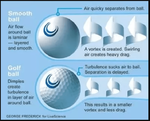I see spin talked about a lot here on THP. I know backspin is desirable when you're flopping balls onto the green. You usually want that ball to hit the green where you're aiming and put on the breaks. Or at least that's the way I work it. I know side spin on full swing hits can be good or bad, depending upon whether you want the ball to draw, fade, or neither.
It's the spin, backspin, I assume, on full-swing hits with drivers, woods, hybrids, and irons about which I'm unclear. How does that spin affect the ball's flight?
For context: What inspired this question was @Jman's recent post in the "B21 or Rad speed" thread:
It's the spin, backspin, I assume, on full-swing hits with drivers, woods, hybrids, and irons about which I'm unclear. How does that spin affect the ball's flight?
For context: What inspired this question was @Jman's recent post in the "B21 or Rad speed" thread:
My point is, and we have seen it here, some guys fit to the Max tried to switch and it was a terrible fit for them because they need the spin. And as you know, the two drivers spin profiles couldn’t be more different.













